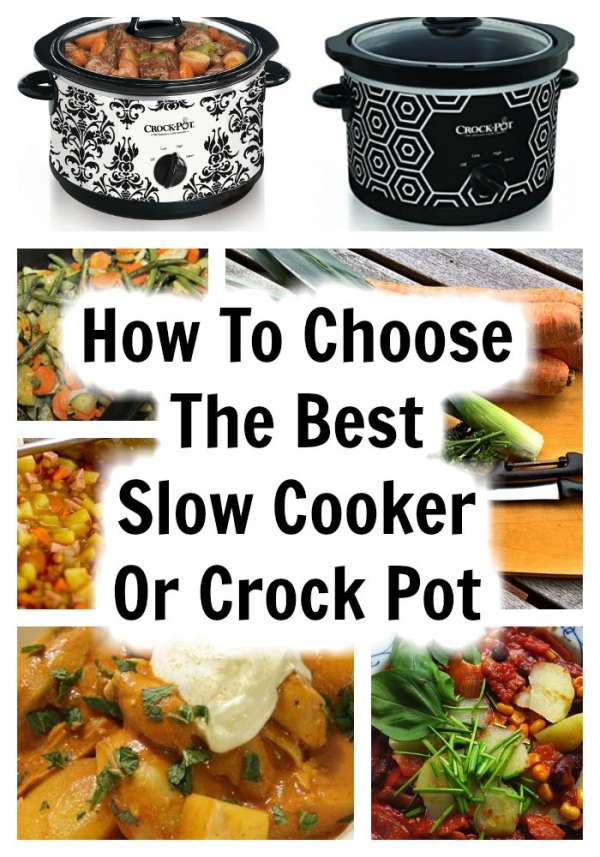
Classic slow cookers still work well, but new models have electronic controls and nonstick aluminum pots.
Electric slow cookers (crock pots) have been used for decades. They are a proven way to easily create delicious meals with minimum effort and skill. Just throw the ingredients into the pot for healthy stews, puddings, soups, and beans. Meat is tenderized by the low heat and long cooking time while releasing little heat to warm up the kitchen in the process.
Slow cookers are ideal for bachelors, college students, and busy parents, offering a simple and delicious alternative to fast food and TV dinners. The long cooking time suits working adults: start the cooker in the morning and come home in the evening to a freshly cooked hot meal.
Models range in capacity from 1.5 quarts to 8 quarts
, with 2 to 6 quarts being the most common. Prices start at $20 and can reach $200. Popular brands include Hamilton Beach
, Rival, and Cuisinart.
How to Choose a Slow Cooker
Choosing the right capacity is important because manufacturers recommend that the pot be filled at least half full for best results. This means that unlike a stockpot or a skillet, playing safe by buying a larger cooker “just in case” has significant drawbacks when cooking small portions. Some “3-in-1” cookers come with different sized pots, allowing the right size to be used depending on the situation.
As a rough guide, 1 to 2 quarts is enough for one person. This means that a 6-quart cooker is suitable for 3 to 6 people. For cooking a whole chicken (not recommended by some for cooking safety reasons: see “temperature probe” below), 6 quarts is a good size. Some pots are actually smaller than the officially stated size.
For smaller cookers, the shape isn’t important. Larger pots should be oval or rectangular to easily fit chickens and ribs.
Slow Cooker Pots and Lids
A removable pot (insert) is easy to clean and can be used as a serving bowl. Ceramic inserts are traditional and are still popular for their heat-retaining capability. Unglazed ceramic is used in some types of ethnic cooking, but glazed ceramic is easier to clean.
Aluminum nonstick inserts are light and tough. They can be used on a stove or in an oven to brown meat and sautee onions, before slow cooking. Some ceramic pots can be heated on gas stoves but need a diffuser grill for use on electric stoves.
Lids are glass or metal. Glass lids are convenient for checking on cooking progress without lifting the lid (lifting the lid is commonly said to lose enough heat to increase cooking time by 30 minutes) but are more fragile.
Some lids have a silicone gasket, and clips to hold the lid closed. They are good for potlucks, carrying a pot full of stew without spilling the pot all over the back seat of the car.
Slow Cooker Temperature Control and Programming
Temperature control is typical “high,” “low,” and “warm.” An auto mode starts on high power and switches to low power once the “low” temperature has been reached.
Digital controls are flexible, but the programming can be complicated. A brief power failure can reset the settings, switching the cooker off, and leaving the uncooked food to spoil.
Programmable digital controls allow a timer to be set for a certain number of hours on “high” or “low.” After the set time, the cooker switches to “warm.” This avoids overcooking if there is any delay in switching off the cooker. Some cookers allow a combination of “high” and “low” to be set.
Maximum timer settings can be 9, 12, or 24 hours depending on the cooker. The time can be set in increments of 30 minutes on some cookers. Other cookers can only be set in increments of 2 hours.
Some cookers come with a temperature probe. This is stuck into the meat through a hole in the lid. When a set temperature is reached, the cooker switches to “warm.” This allows whole chickens and large pieces of meat to be cooked to a safe temperature, killing bacteria even in the center of the meat.
Electronic slow cookers with timers that can automatically switch to “warm” are good for working adults and couples, people who are out most of the day, and may sometimes come home late.
Traditional mechanical dial slow cookers are simple and reliable, suitable for stay-home cooks and full-time homemakers.
Toaster and turbo convection ovens are also a way to make simple, good-tasting meals.





Leave a Reply